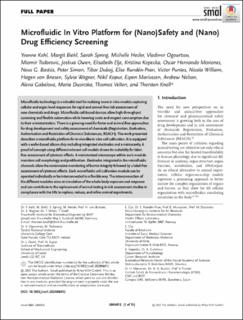Microfluidic In Vitro Platform for (Nano)Safety and (Nano)Drug Efficiency Screening
Kohl, Yvonne; Biehl, Margit; Spring, Sarah; Hesler, Michelle; Ogourtsov, Vladimir; Todorovic, Miomir; Owen, Joshua; Elje, Elisabeth; Kopecka, Kristina; Moriones, Oscar Hernando; Bastus, Neus G.; Simon, Peter; Dubaj, Tibor; Rundén-Pran, Elise; Puntes, Victor; William, Nicola; von Briesen, Hagen; Wagner, Sylvia; Kapur, Nikil; Mariussen, Espen; Nelson, Andrew; Gabelova, A; Dusinska, Maria; Velten, Thomas; Knoll, Thorsten
Peer reviewed, Journal article
Published version
Permanent lenke
https://hdl.handle.net/11250/2724914Utgivelsesdato
2021Metadata
Vis full innførselSamlinger
- Publikasjoner fra Cristin - NILU [1360]
- Vitenskapelige publikasjoner [1096]
Sammendrag
Microfluidic technology is a valuable tool for realizing more in vitro models capturing cellular and organ level responses for rapid and animal‐free risk assessment of new chemicals and drugs. Microfluidic cell‐based devices allow high‐throughput screening and flexible automation while lowering costs and reagent consumption due to their miniaturization. There is a growing need for faster and animal‐free approaches for drug development and safety assessment of chemicals (Registration, Evaluation, Authorisation and Restriction of Chemical Substances, REACH). The work presented describes a microfluidic platform for in vivo‐like in vitro cell cultivation. It is equipped with a wafer‐based silicon chip including integrated electrodes and a microcavity. A proof‐of‐concept using different relevant cell models shows its suitability for label‐free assessment of cytotoxic effects. A miniaturized microscope within each module monitors cell morphology and proliferation. Electrodes integrated in the microfluidic channels allow the noninvasive monitoring of barrier integrity followed by a label‐free assessment of cytotoxic effects. Each microfluidic cell cultivation module can be operated individually or be interconnected in a flexible way. The interconnection of the different modules aims at simulation of the whole‐body exposure and response and can contribute to the replacement of animal testing in risk assessment studies in compliance with the 3Rs to replace, reduce, and refine animal experiments.

